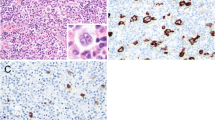Abstract
Recently, Ewing's tumours have been shown to carry specific hybrid transcripts resulting from the fusion of the EWS gene with FLI-1 or ERG genes. Based on the sensitivity and specificity of the detection of these alterations by the reverse transcriptase-polymerase chain reaction technique, we have developed an assay to search for small numbers of Ewing cells in various sites from patients with Ewing's tumour. This method enables the detection of fewer than one tumour cell per million blood mononuclear cells. A total of 28 primary sites and 51 peripheral samples from 36 patients were investigated. Tumour cells could be detected in 4/18 blood samples, 4/15 bone marrow aspirates and 2/18 peripheral stem cell harvests. EWS/FLI-1 and EWS/ERG transcripts being observed in eight and two cases respectively. The type of fusion transcript detected in peripheral site(s) was identical to that observed in the primary site. At diagnosis 5/16 patients (31%) demonstrated either circulating tumour cells or/and occult bone marrow metastasis. After induction therapy, tumour cells were detected in 3/21 patients. This highly sensitive method should be a relevant tool to allow a more accurate clinical assessment of the dissemination of Ewing's tumours.
Similar content being viewed by others
Author information
Authors and Affiliations
Rights and permissions
About this article
Cite this article
Peter, M., Magdelenat, H., Michon, J. et al. Sensitive detection of occult Ewing's cells by the reverse transcriptase-polymerase chain reaction. Br J Cancer 72, 96–100 (1995). https://doi.org/10.1038/bjc.1995.283
Issue Date:
DOI: https://doi.org/10.1038/bjc.1995.283
- Springer Nature Limited
This article is cited by
-
Release of circulating tumor cells and cell-free nucleic acids is an infrequent event in synovial sarcoma: liquid biopsy analysis of 15 patients diagnosed with synovial sarcoma
Diagnostic Pathology (2018)
-
Circulating tumor cells in sarcomas: a brief review
Medical Oncology (2015)
-
Gene expression profiling of peripheral blood cells: new insights into Ewing sarcoma biology and clinical applications
Medical Oncology (2014)
-
Incidence and prognostic value of tumour cells detected by RT–PCR in peripheral blood stem cell collections from patients with Ewing tumour
British Journal of Cancer (2006)
-
Type 1 (11; 22)(q24: q12) translocation is common in Ewing’s sarcoma/ peripheral neuroectodermal tumour in south Indian patients
Journal of Biosciences (2005)




